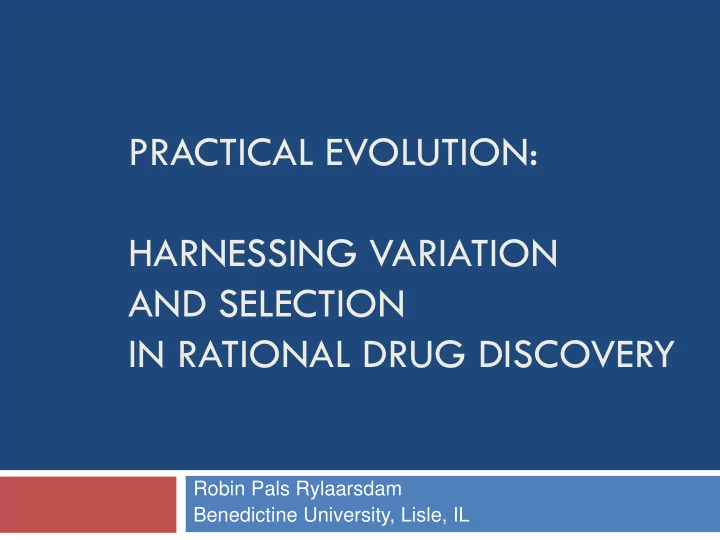

PRACTICAL EVOLUTION: HARNESSING VARIATION AND SELECTION IN RATIONAL DRUG DISCOVERY Robin Pals Rylaarsdam Benedictine University, Lisle, IL
“Evolution” in hearts and minds
Useful principles of evolution Protein homologies Conservation of biochemical pathways Variation and selection
McCune-Albright Syndrome Mosaicism for constitutively active G α s Precocious puberty, Café-au-lait hyperpigmentation, Polyostotic fibrous dysplasia of bone Other hyperendocrinopathies 3 possible mutations in Gs protein: R201H, R201C, R201S
Normal Gs Signaling Hormone Adenyly cyclase GPCR α α βγ βγ GTP MAPK ATP cAMP GDP cascade RESPONSE RESPONSE
Cells carrying the MAS mutation have constitutively active signaling Hormone Adenyly cyclase GPCR α α βγ βγ GTP MAPK ATP cAMP GDP cascade RESPONSE RESPONSE
Useful principles of evolution Setting up a model system Conservation of biochemical pathways Protein homologies Finding drug targets Variation and selection
Homologous biochemical pathways – proteins are conserved between yeast and humans
Homologous biochemical pathways – proteins are conserved between yeast and humans Pheromone Normal yeast signaling α α βγ βγ GTP MAPK GDP cascade Temporary cell-cycle arrest G α -GDP inactivates βγ to restore cell division
Protein similarities Blue = different Green & warmer = similar to identical. Yeast 3 human G-protein genes Nematode Fruit fly
Common sequence, common structure
Homologous mutation in yeast G α causes same biochemical defect as in human protein Yeast with overactive G α α * βγ MAPK GTP cascade Permanent cell-cycle arrest No G α -GDP inactivation of βγ without a suppressor mutation
The MAS mutation activates yeast G α like the human gene FOA Transfected plasmid:
Useful principles of evolution Setting up a model system Protein homologies Conservation of biochemical pathways Finding drug targets Variation and selection
Homologous mutation in yeast G α causes same biochemical defect as in human protein Yeast with overactive G α α * α ** βγ α ** MAPK GTP GTP βγ cascade GXP Permanent cell-cycle arrest No G α -GDP inactivation of βγ without a suppressor mutation Inactivation of βγ Restoration of cell cycle progression Colony formation
Variation
Randomly mutated library screened for intragenic suppressor mutations of an “MAS allele” Library: 7800 unique mutants in Gpa1 R297H 55,000 clones screened 39 Clones remained FOA R 424 colonies grew on FOA , plasmids were sequenced
14/39 suppressor mutation sites are conserved between Gs and the yeast GPA1
Do the mutations that suppress the yeast G- protein also suppress the human G-protein? Hormone Adenyly cyclase GPCR α α βγ βγ GTP MAPK ATP cAMP GDP cascade RESPONSE RESPONSE
Homology is not identity, but it works sometimes! 100 80 (% forskolin response) Basal cAMP 60 * * * 40 * ** 20 ** 0 T H S T S R C A I G R T T 6 2 6 3 W 2 3 1 0 1 2 9 0 5 8 6 8 0 4 1 2 3 4 0 2 5 1 1 2 2 3 2 2 2 2 2 3 V I L I R F Q H R T K E R201H +
Examining the variations at each site that can suppress the MAS mutation L266 100 cAMP (% forskolin response) 75 50 * 25 F142 * * F146 * 0 WT R201H R231C R231S R231A R231E R231I R231K F140 R201H + E268 R231
McCune-Albright Syndrome Mosaicism for constitutively active G α s Precocious puberty, Café-au-lait hyperpigmentation, Polyostotic fibrous dysplasia of bone Other hyperendocrinopathies 3 possible mutations in Gs protein: R201H, R201C, R201S
Other MAS alleles are suppressed by changes at these three sites 100 (% forskolin response) 80 Basal cAMP 60 40 * * * 20 * * * 0 WT R201C R201C/F142S R201C/R231C R201C/L266T R201S R201S/F142S R201S/R231C R201S/L266N
Cells carrying the MAS mutation have constitutively active signaling Hormone Adenyly cyclase GPCR α∗ α∗ βγ βγ GTP MAPK ATP cAMP GDP cascade RESPONSE RESPONSE RESPONSE RESPONSE
Choosing a target site F142 F146 E268 R231 F140 L266
Finding molecules that bind at R231
Dose-Dependent Relationships of Drugs 3 and 18 40 30 pmol cAMP / 25 ul lysate pmol cAMP / 25 ul lysate 30 20 20 10 10 18 3 IC 50 : 0.1 µ M IC 50 : 0.8 µ M 0 0 -10 -8 -6 -4 -10 -8 -6 -4 [DRUG], M [DRUG], M
Conclusions: McCune-Albright syndrome can be Protein homologies modeled at the cellular level using yeast Several intragenic suppressors of R201H Homologous biochemical activity were identified, these mutations pathways alone do not abolish Gs signaling. Variation and The intragenic suppressors were able to selection suppress R201C and R201S mutations processes applied to We have identified two molecules that drug design inhibit Gs-R201H in a dose-dependent Evolution is manner used to heal disease
Pilot studies Site-directed mutagenesis Matthew Koster, MD Kyle Turcic, MD Joshua Mitchell, MD Alison Dufour, MS Laura Ooms, Ph.D. Raquel Tobar-Rubin, PharmD Dahlia Sultan, PharmD Julie Carroll, MD Brittany Swen, DPT Regina Herrera, DDS Drug screens Julie Carroll, MD Yeast library construction & screen Renee Habbal, DDS Daniela Janevska, Ph.D. Evan Jenkins, MD Eraj Din, MD Joe Cruz Jennifer Haick, Ph.D. Matthew Raub Rebecca Alvarez Morgan Schumacher, MD Support and Collaborators • NIH 1R15DE020190-01 • Benedictine University, Scholl Endowment in the Natural Sciences • Dr. Eric Walters, Rosalind Franklin University
Recommend
More recommend